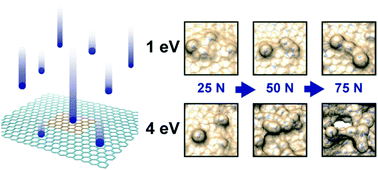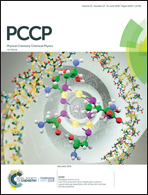Structural transformations of graphene exposed to nitrogen plasma: quantum chemical molecular dynamics simulations†
Abstract
Nitrogen-doped graphene (N-graphene) has been intensively studied for tailoring the electronic property of the graphene, because different nitrogen configurations influence the electronic properties of N-graphene in different ways. However, atomically precise control of the nitrogen configurations during the doping process remains a challenge in the synthesis of N-graphene. Moreover, additional structural transformations of the graphene carbon network structure as a side-effect of plasma doping are little understood and are as of yet uncontrollable. Therefore, we theoretically investigated the nitrogen doping process of graphene for a range of nitrogen atom incident kinetic energies in nonequilibrium quantum chemical molecular dynamics (QM/MD) simulations. We observed and characterized prominent configurations of N-containing graphene. In analogy to similar, earlier studies of graphene plasma hydrogenation, we observed an Eley–Rideal associative desorption mechanism during the graphene plasma nitrogenation, producing molecular nitrogen. Especially for graphitic-N (Gr-N) and Stone–Wales-defect-N (SW-N) configurations, which are frequently observed in experimental studies, we discovered two typical chemical reaction mechanisms which were well categorized by two key processes: adsorption of primary nitrogen dopant and collision with a secondary nitrogen dopant. We discussed effects of the incident nitrogen energy on the formation mechanism, and propose a method to generate of Gr-N and SW-N configurations selectively by tuning the conditions with respect to the two key formation processes.



 Please wait while we load your content...
Please wait while we load your content...